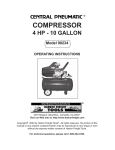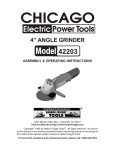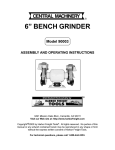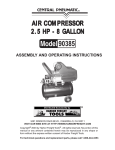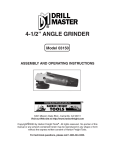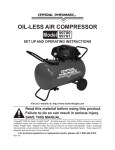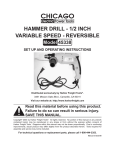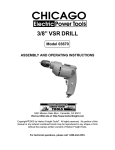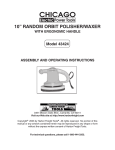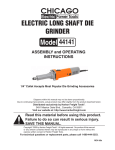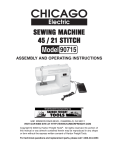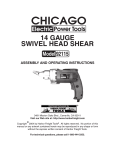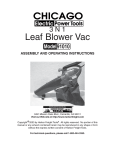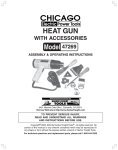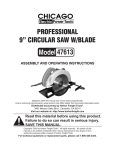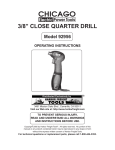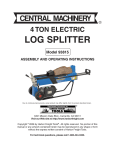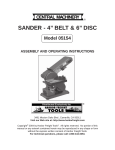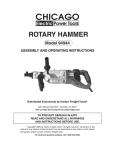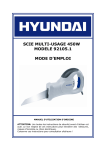Download Harbor Freight Tools 45338 User's Manual
Transcript
HAMMER DRILL - 1/2 INCH VARIABLE SPEED - REVERSIBLE 45338 ASSEMBLY AND OPERATING INSTRUCTIONS 3491 MISSION OAKS BLVD., CAMARILLO, CA 93011 VISIT OUR WEB SITE AT HTTP://WWW.HARBORFREIGHT.COM Copyright © 2003 by Harbor Freight Tools®. All rights reserved. No portion of this manual or any artwork contained herein may be reproduced in any shape or form without the express written consent of Harbor Freight Tools. For technical questions and replacement parts, please call 1-800-444-3353 SPECIFICATIONS Ite m P o w e r C o n s u m p tio n M o to r C h u c k C a p a c ity C h u c k T h re a d Speed S w itc h P o w e r C o rd W e ig h t F e a tu re s D e s c rip tio n 1 2 0 V A C , 6 0 H z , s in g le p h a s e , 6 .3 a m p s (lo a d ), 7 5 0 w a tts D o u b le in s u la te d 3 /6 4 to 1 /2 in c h , p lu s k e y c h u c k 1 /2 " - 2 0 U N F 0 ~ 2 8 0 0 R P M (n o lo a d ); 0 ~ 4 2 ,0 0 0 B P M E le c tro n ic v a ria b le s p e e d trig g e r, fo rw a rd a n d re v e rs e ; c o n tin u o u s ru n trig g e r lo c k ; m a x im u m speed set 6 fe e t lo n g , 1 8 A W G /2 C , 2 -p ro n g p o la riz e d p lu g , U L lis te d 4 .9 lb s . - H ig h Im p a c t H o u s in g - S id e g rip h a n d le - B e lt h o o k - D e p th g a u g e - R e m o v a b le c h u c k - Id e a l fo r h a rd m a te ria ls : c o n c re te , m a rb le , a n d s te e l E194601 SAVE THIS MANUAL You will need the manual for the safety warnings and precautions, assembly instructions, operating and maintenance procedures, parts list and diagram. Keep your invoice with this manual. Write the invoice number on the inside of the front cover. Keep the manual and invoice in a safe and dry place for future reference. GENERAL SAFETY RULES WARNING! READ AND UNDERSTAND ALL INSTRUCTIONS. Failure to follow all instructions listed below may result in electric shock, fire, and/or serious injury. SAVE THESE INSTRUCTIONS Work Area 1. Keep your work area clean and well lit. Cluttered benches and dark areas invite accidents. 2. Do not operate power tools in explosive atmospheres, such as in the presence of flammable liquids, gases, or dust. Power tools create sparks which may ignite the dust or fumes. 3. Keep bystanders, children, and visitors away while operating a power tool. Distractions can cause you to lose control. Protect others in the work area from debris such as chips and sparks. Provide barriers or shields as needed. SKU 45338 Page 2 Electrical Safety 4. Avoid body contact with grounded surfaces such as pipes, radiators, ranges, and refrigerators. There is an increased risk of electric shock if your body is grounded. 5. Do not expose power tools to rain or wet conditions. Water entering a power tool will increase the risk of electric shock. 6. Grounded tools must be plugged into an outlet properly installed and grounded in accordance with all codes and ordinances. Never remove the grounding prong or modify the plug in any way. Do not use any adapter plugs. Check with a qualified electrician if you are in doubt as to whether the outlet is properly grounded. If the tools should electrically malfunction or break down, grounding provides a low resistance path to carry electricity away from the user. 7. This Double insulated Hammer Drill is equipped with a polarized plug (one blade is wider than the other). This plug will fit in a polarized outlet only one way. If the plug does not fit fully in the outlet, reverse the plug. If it still does not fit, contact a qualified electrician to install a polarized outlet. Do not change the plug in any way. Double insulation eliminates the need for the three wire grounded power cord and grounded power supply system. 8. Do not abuse the Power Cord. Never use the Power Cord to carry the tools or pull the Plug from an outlet. Keep the Power Cord away from heat, oil, sharp edges, or moving parts. Replace damaged Power Cords immediately. Damaged Power Cords increase the risk of electric shock. 9. When operating a power tool outside, use an outdoor extension cord marked “W-A” or “W”. These extension cords are rated for outdoor use, and reduce the risk of electric shock. Personal Safety 10. Stay alert. Watch what you are doing, and use common sense when operating a power tool. Do not use a power tool while tired or under the influence of drugs, alcohol, or medication. A moment of inattention while operating power tools may result in serious personal injury. 11. Dress properly. Do not wear loose clothing or jewelry. Contain long hair. Keep your hair, clothing, and gloves away from moving parts. Loose clothes, jewelry, or long hair can be caught in moving parts. 12. Avoid accidental starting. Be sure the Power Switch is off before plugging in. Carrying power tools with your finger on the Power Switch, or plugging in power tools with the Power Switch on, invites accidents. 13. Remove adjusting keys or wrenches before turning the power tool on. A wrench or a key that is left attached to a rotating part of the power tool may result in personal injury. SKU 45338 Page 3 14. Do not overreach. Keep proper footing and balance at all times. Proper footing and balance enables better control of the power tool in unexpected situations. 15. Use safety equipment. Always wear eye protection. Dust mask, non-skid safety shoes, hard hat, or hearing protection must be used for appropriate conditions. Tool Use and Care 16. Use clamps (not included) or other practical ways to secure and support the workpiece to a stable platform. Holding the work by hand or against your body is unstable and may lead to loss of control. 17. Do not force the tool. Use the correct tool for your application. The correct tool will do the job better and safer at the rate for which it is designed. 18. Do not use the power tool if the Power Switch does not turn it on or off. Any tool that cannot be controlled with the Power Switch is dangerous and must be replaced. 19. Disconnect the Power Cord Plug from the power source before making any adjustments, changing accessories, or storing the tool. Such preventive safety measures reduce the risk of starting the tool accidentally. 20. Store idle tools out of reach of children and other untrained persons. Tools are dangerous in the hands of untrained users. 21. Maintain tools with care. Keep cutting tools sharp and clean. Properly maintained tools with a sharp cutting edge are less likely to bind and are easier to control. Do not use a damaged tool. Tag damaged tools “Do not use” until repaired. 22. Check for misalignment or binding of moving parts, breakage of parts, and any other condition that may affect the tool’s operation. If damaged, have the tool serviced before using. Many accidents are caused by poorly maintained tools. 23. Use only accessories that are recommended by the manufacturer for your model. Accessories that may be suitable for one tool may become hazardous when used on another tool. Service 24. Tool service must be performed only by qualified repair personnel. Service or maintenance performed by unqualified personnel could result in a risk of injury. 25. When servicing a tool, use only identical replacement parts. Follow instructions in the “Inspection, Maintenance, And Cleaning” section of this manual. Use of unauthorized parts or failure to follow maintenance instructions may create a risk of electric shock or injury. SKU 45338 Page 4 SPECIFIC SAFETY RULES FOR THE HAMMER DRILL 1. Hold tool by insulated gripping surfaces when performing an operation where the cutting tools may contact hidden wiring or its own cord. Contact with a ”live” wire will make exposed metal parts of the tool “live” and shock the operator. 2. Maintain labels and nameplates on the Hammer Drill. These carry important information. If unreadable or missing, contact Harbor Freight Tools for a replacement. 3. Always wear safety impact eye goggles and heavy work gloves when using the Hammer Drill. Using personal safety devices reduce the risk for injury. Safety impact eye goggles and heavy work gloves are available from Harbor Freight Tools. 4. Maintain a safe working environment. Keep the work area well lit. Make sure there is adequate surrounding workspace. Always keep the work area free of obstructions, grease, oil, trash, and other debris. Do not use a power tool in areas near flammable chemicals, dusts, and vapors. Do not use this product in a damp or wet location. 5. Avoid unintentional starting. Make sure you are prepared to begin work before turning on the Hammer Drill. 6. Do not force the Hammer Drill. This tool will do the work better and safer at the speed and capacity for which it was designed. 7. Always unplug the Hammer Drill from its electrical outlet before performing and inspection, maintenance, or cleaning procedures. 8. WARNING! Some dust created by power sanding, sawing, grinding, drilling, and other construction activities, contain chemicals known (to the State of California) to cause cancer, birth defects or other reproductive harm. Some examples of these chemicals are: lead from lead-based paints, crystalline silica from bricks and cement or other masonry products, arsenic and chromium from chemically treated lumber. Your risk from these exposures varies, depending on how often you do this type of work. To reduce your exposure to these chemicals: work in a well ventilated area, and work with approved safety equipment, such as those dust masks that are specially designed to filter out microscopic particles. (California Health & Safety Code 25249.5, et seq.) 9. WARNING! People with pacemakers should consult their physician(s) before using this product. Operation of electrical equipment in close proximity to a heart (1)cause interference or failure of the pacemaker. pacemaker could 10. Never leave the Hammer Drill unattended while running. Turn power off if you have to leave the Hammer Drill. 11. Before each use, check all nuts, bolts, and screws for tightness. Vibration may cause these to loosen. 12. Keep extension cord away from water. 13. Always connect the Line Cord to a Ground Fault Circuit Interrupter (GFCI) protected electrical outlet. SKU 45338 Page 5 GROUNDING WARNING! Improperly connecting the grounding wire can result in the risk of electric shock. Check with a qualfified electrician if you are in doubt as to whether the outlet is properly grounded. Do not modify the power cord plug provided with the tool. Never remove the grounding prong from the plug. Do not use the tool if the power cord or plug is damaged. If damaged, have it repaired by a service facility before use. If the plug will not fit the outlet, have a proper outlet installed by a qualified electrician. Grounded Tools: Tools with Three Prong Plugs 1. Tools marked with “Grounding Required” have a three wire cord and three prong grounding plug. The plug must be connected to a properly grounded outlet. If the tool should electrically malfunction or break down, grounding provides a low resistance path to carry electricity away from the user, reducing the risk of electric shock. (See Figure A.) 2. The grounding prong in the plug is connected through the green wire inside the cord to the grounding system in the tool. The green wire in the cord must be the only wire connected to the tool’s grounding system and must never be attached to an electrically “live” terminal. (See Figure A.) 3. Your tool must be plugged into an appropriate outlet, properly installed and grounded in accordance with all codes and ordinances. The plug and outlet should look like those in the following illustration. (See Figure A.) Figure A Figure B Double Insulated Tools: Tools with Two Prong Plugs 4. This tool is double insulated. Tools marked “Double Insulated” do not require grounding. They have a special double insulation system which satisfies OSHA requirements and complies with the applicable standards of Underwriters Laboratories, Inc., the Canadian Standard Association, and the National Electrical Code. (See Figure B above.) 5. Double insulated tools may be used in either of the 120 volt outlets shown in the following illustration. (See Figure B above.) SKU 45338 Page 6 EXTENSION CORDS 1. Grounded tools require a three wire extension cord. Double Insulated tools (like this one) can use either a two or three wire extension cord. 2. As the distance from the supply outlet increases, you must use a heavier gauge extension cord. Using extension cords with inadequately sized wire causes a serious drop in voltage, resulting in loss of power and possible tool damage. (See Table A.) 3. The smaller the gauge number of the wire, the greater the capacity of the cord. For example, a 14 gauge cord can carry a higher current than a 16 gauge cord. (See Table A.) 4. When using more than one extension cord to make up the total length, make sure each cord contains at least the minimum wire size required. (See Table A.) 5. If you are using one extension cord for more than one tool, add the nameplate amperes and use the sum to determine the required minimum cord size. (See Table A.) 6. If you are using an extension cord outdoors, make sure it is marked with the suffix “WA” (“W” in Canada) to indicate it is acceptable for outdoor use. 7. Make sure your extension cord is properly wired and in good electrical condition. Always replace a damaged extension cord or have it repaired by a qualified electrician before using it. 8. Protect your extension cords from sharp objects, excessive heat, and damp or wet areas. Table A RECO M M ENDED M INIM UM W IRE G AUG E FO R EXTENSIO N CO RDS* (120 VO LT) NAM EPLATE AM PER ES (At Full Load) EXTENSIO N CO R D LENG TH 25 50 75 100 150 Feet Feet Feet Feet Feet 0 – 2.0 18 18 18 18 16 2.1 – 3.4 18 18 18 16 14 3.5 – 5.0 18 18 16 14 12 5.1 – 7.0 18 16 14 12 12 7.1 – 12.0 18 14 12 10 12.1 – 16.0 14 12 10 16.1 – 20.0 12 10 * Based on lim iting the line voltage drop to five volts at 150% of the rated am peres. SKU 45338 Page 7 SYMBOLOGY Table B UNPACKING When unpacking, check to make sure that all the parts are included. See Figure C. Also refer to the Assembly section, and the Assembly Drawing and Parts List at the end of this manual. Figure C Chuck (2) Depth Gauge (502) Auxiliary Handle (501) Chuck Key (3) If any parts are missing or broken, please call Harbor Freight Tools at the number on the cover of this manual as soon as possible. SKU 45338 Page 8 ASSEMBLY INSTRUCTIONS 1. Insert the Auxiliary Handle (501) over the Housing (29) until it rests behind the Chuck (2). When required for exact depth drilling, insert the Depth Gauge (502) into the Auxiliary Handle clamp. See Figure D below. 2. Turn the Forward Handle for left or right-handed use, then securely tighten the wing nut until Auxiliary Handle cannot move. Figure D Housing (29) Auxiliary Handle (501) Chuck (2) Depth Gauge (502) Wing Nut OPERATING INSTRUCTIONS Inserting and Removing Drill and Hammer Bits The Hammer Drill is equipped with a keyed Chuck (2). Follow these steps to insert a bit. 1. Insert the Chuck Key (3) into the Chuck (2) and turn counterclockwise to open the mouth of the Chuck. 2. Insert the hammer bit or the drill bit (not supplied) all the way into the Chuck. 3. Turn the Chuck Key clockwise to tighten the Chuck on the bit. Drill Operation 1. Plug the Line Cord into an electrical outlet. 2. Press the Forward/Reverse Switch to correct position for the current job. See Figure E on the next page. Right position: drill or fasten (clockwise). Left position: removing fasteners or freeing bits (counterclockwise). SKU 45338 Page 9 Figure E Forward/Reverse Switch Switch On Locking Button Variable Speed Screw Trigger Switch (24) 3. Adjust the Variable Speed Screw for the desired (maximum) speed action when the Switch is pressed. 4. For precision depth drilling, loosen the Wing Nut securing the Auxiliary Handle (501), and slide the Depth Gauge (502) down, gauging the depth from the bit tip. Retighten the Wing Nut again. 5. Verify that the bit is securely locked in the Chuck (2). 6. On the top of the Hammer Drill, push the Gear Setting Control to select plain drilling or hammer drilling. A symbol for a drill bit indicates plain drilling is selected. If a hammer is shown, it is set for hammer drilling. See Figure F below. Figure F Note: While using the Hammer Drill, always use both hands. Top View Gear Setting Control 7. Press (and hold) the trigger Switch (24) to turn the drill on. This Switch varies the speed depending on how far in it is pressed. 8. Optionally, after pressing in the trigger Switch, you can press the Switch On Locking Button to keep the drill running without keeping your finger on the trigger Switch (24). Use this function when drilling soft materials only. Press the trigger Switch again to turn it off. 9. When you are finished drilling, release the trigger Switch to turn the Hammer Drill off. Caution: Do not drill or hammer hard, brittle materials such as steel or concrete with the Switch On Locking Button pressed in (ON). If the drill bit catches on the material, the high torque of the drill will cause the tool body to twist around without stopping. This violent action could cause injuries to your hands and arms. It could also damage the Hammer Drill. SKU 45338 Page 10 INSPECTION, MAINTENANCE, AND CLEANING Caution! Make sure the Power Switch of the Hammer Drill is in its “OFF” position and that the tool is unplugged from its electrical outlet before performing any inspection, maintenance, or cleaning procedures. 1. Before each use, inspect the general condition of the Hammer Drill. Check for loose screws, misalignment or binding of moving parts, cracked or broken parts, damaged electrical wiring, and any other condition that may affect its safe operation. If abnormal noise or vibration occurs, have the problem corrected before further use. Do not use damaged equipment. 2. Periodically recheck all nuts, bolts, and screws for tightness. 3. Keep clean by wiping with a clean, damp cloth. Never use caustic agents to clean plastic parts. 4. Store in a clean and dry location when not in use. 5. Periodically, using a rag and light oil, wipe drill bits and other steel parts of the drill to keep them from rusting. 6. Periodically blow out the motor air vents of dust and debris using compressed air. 7. Over time, if the performance of the tool diminishes, or it stops working completely, it may be necessary to replace the motor’s Carbon Brush (21). If the Carbon Brush is only dirty, it can be cleaned with an ink eraser and replaced again. Replacing or cleaning Carbon Brushes must be completed by a qualified service technician. PLEASE READ THE FOLLOWING CAREFULLY THE MANUFACTURER AND/OR DISTRIBUTOR HAS PROVIDED THE PARTS DIAGRAM IN THIS MANUAL AS A REFERENCE TOOL ONLY. NEITHER THE MANUFACTURER NOR DISTRIBUTOR MAKES ANY REPRESENTATION OR WARRANTY OF ANY KIND TO THE BUYER THAT HE OR SHE IS QUALIFIED TO MAKE ANY REPAIRS TO THE PRODUCT OR THAT HE OR SHE IS QUALIFIED TO REPLACE ANY PARTS OF THE PRODUCT. IN FACT, THE MANUFACTURER AND/OR DISTRIBUTOR EXPRESSLY STATES THAT ALL REPAIRS AND PARTS REPLACEMENTS SHOULD BE UNDERTAKEN BY CERTIFIED AND LICENSED TECHNICIANS AND NOT BY THE BUYER. THE BUYER ASSUMES ALL RISK AND LIABILITY ARISING OUT OF HIS OR HER REPAIRS TO THE ORIGINAL PRODUCT OR REPLACEMENT PARTS THERETO, OR ARISING OUT OF HIS OR HER INSTALLATION OF REPLACEMENT PARTS THERETO. SKU 45338 Page 11 REV 06/04 PARTS LIST Item No. 1. 2. 3. 4. 5. 6. 7. 8. 9. 10. 11. 12. 13. 14. 15. 16. 17. 18. 19. 20. 21. 22. 23. 24. 25. 26. 27. 28. 29. 30. 31. 32. 33. 34. 501. 502. Description Screw, M6x25 Chuck Chuck Key Spindle Steel Ball, 3 Circle Seal Ball Bearing Spring Gear, Large Needle Bearing, HK1207 Ratchet Bearing Holder Washer Steel Ball Ball Bearing, 62900 Armature Stator Ball Baring, 80018 Change Knob Brush Cap Carbon Brush Brush Holder Inductor Switch Internal Wire Condenser Screw, ST4x14 Cord Clip Housing, A and B Rubber Sleeve Cord Name Plate Cushion Screw, ST4x18 Auxiliary Handle Depth Gauge Qty. 1 1 1 1 1 1 1 1 1 1 1 1 1 1 1 1 1 1 1 1 2 2 2 1 6 1 2 1 1 1 1 1 1 8 1 1 NOTE: Some parts are listed and shown for illustration purposes only and are not available individually as replacement parts. SKU 45338 Page 12 ASSEMBLY DRAWING SKU 45338 Page 13













